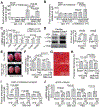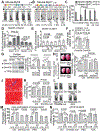Epigenetic response to environmental stress: Assembly of BRG1-G9a/GLP-DNMT3 repressive chromatin complex on Myh6 promoter in pathologically stressed hearts
- PMID: 26952936
- PMCID: PMC7397641
- DOI: 10.1016/j.bbamcr.2016.03.002
Epigenetic response to environmental stress: Assembly of BRG1-G9a/GLP-DNMT3 repressive chromatin complex on Myh6 promoter in pathologically stressed hearts
Abstract
Chromatin structure is determined by nucleosome positioning, histone modifications, and DNA methylation. How chromatin modifications are coordinately altered under pathological conditions remains elusive. Here we describe a stress-activated mechanism of concerted chromatin modification in the heart. In mice, pathological stress activates cardiomyocytes to express Brg1 (nucleosome-remodeling factor), G9a/Glp (histone methyltransferase), and Dnmt3 (DNA methyltransferase). Once activated, Brg1 recruits G9a and then Dnmt3 to sequentially assemble repressive chromatin-marked by H3K9 and CpG methylation-on a key molecular motor gene (Myh6), thereby silencing Myh6 and impairing cardiac contraction. Disruption of Brg1, G9a or Dnmt3 erases repressive chromatin marks and de-represses Myh6, reducing stress-induced cardiac dysfunction. In human hypertrophic hearts, BRG1-G9a/GLP-DNMT3 complex is also activated; its level correlates with H3K9/CpG methylation, Myh6 repression, and cardiomyopathy. Our studies demonstrate a new mechanism of chromatin assembly in stressed hearts and novel therapeutic targets for restoring Myh6 and ventricular function. The stress-induced Brg1-G9a-Dnmt3 interactions and sequence of repressive chromatin assembly on Myh6 illustrates a molecular mechanism by which the heart epigenetically responds to environmental signals. This article is part of a Special Issue entitled: Cardiomyocyte Biology: Integration of Developmental and Environmental Cues in the Heart edited by Marcus Schaub and Hughes Abriel.
Keywords: Brg1; Cardiac hypertrophy; Cardiomyopathy; Chromatin remodeling; DNA methylation; Dnmt; G9a; Gene silencing; H3K9me2; Heart failure; Histone methylation; Myosin heavy chain.
Copyright © 2016. Published by Elsevier B.V.
Conflict of interest statement
Conflict of interest
The authors have not conflict of interest to report at this time.
Figures






Similar articles
-
A long noncoding RNA protects the heart from pathological hypertrophy.Nature. 2014 Oct 2;514(7520):102-106. doi: 10.1038/nature13596. Epub 2014 Aug 10. Nature. 2014. PMID: 25119045 Free PMC article.
-
Chromatin regulation by Brg1 underlies heart muscle development and disease.Nature. 2010 Jul 1;466(7302):62-7. doi: 10.1038/nature09130. Nature. 2010. PMID: 20596014 Free PMC article.
-
Histone Methyltransferase G9a Is Required for Cardiomyocyte Homeostasis and Hypertrophy.Circulation. 2017 Sep 26;136(13):1233-1246. doi: 10.1161/CIRCULATIONAHA.117.028561. Epub 2017 Aug 4. Circulation. 2017. PMID: 28778944
-
Epigenetic and lncRNA regulation of cardiac pathophysiology.Biochim Biophys Acta. 2016 Jul;1863(7 Pt B):1767-71. doi: 10.1016/j.bbamcr.2016.03.005. Epub 2016 Mar 9. Biochim Biophys Acta. 2016. PMID: 26969820 Free PMC article. Review.
-
The role of chromatin repressive marks in cognition and disease: A focus on the repressive complex GLP/G9a.Neurobiol Learn Mem. 2015 Oct;124:88-96. doi: 10.1016/j.nlm.2015.06.013. Epub 2015 Jul 2. Neurobiol Learn Mem. 2015. PMID: 26143996 Review.
Cited by
-
Prediction of diagnostic gene biomarkers for hypertrophic cardiomyopathy by integrated machine learning.J Int Med Res. 2023 Nov;51(11):3000605231213781. doi: 10.1177/03000605231213781. J Int Med Res. 2023. PMID: 38006610 Free PMC article.
-
Approaching Sex Differences in Cardiovascular Non-Coding RNA Research.Int J Mol Sci. 2020 Jul 10;21(14):4890. doi: 10.3390/ijms21144890. Int J Mol Sci. 2020. PMID: 32664454 Free PMC article. Review.
-
Myocardial plasticity: cardiac development, regeneration and disease.Curr Opin Genet Dev. 2016 Oct;40:120-130. doi: 10.1016/j.gde.2016.05.029. Epub 2016 Aug 4. Curr Opin Genet Dev. 2016. PMID: 27498024 Free PMC article. Review.
-
The expanding role of the Ehmt2/G9a complex in neurodevelopment.Neurogenesis (Austin). 2017 May 2;4(1):e1316888. doi: 10.1080/23262133.2017.1316888. eCollection 2017. Neurogenesis (Austin). 2017. PMID: 28596979 Free PMC article.
-
Epigenetic Mechanisms in Heart Diseases.Rev Cardiovasc Med. 2025 Jul 30;26(7):38696. doi: 10.31083/RCM38696. eCollection 2025 Jul. Rev Cardiovasc Med. 2025. PMID: 40776938 Free PMC article. Review.
References
-
- Abraham WT, Gilbert EM, Lowes BD, Minobe WA, Larrabee P, Roden RL, Dutcher D, Sederberg J, Lindenfeld JA, Wolfel EE, et al., Coordinate changes in Myosin heavy chain isoform gene expression are selectively associated with alterations in dilated cardiomyopathy phenotype, Mol. Med 8 (2002) 750–760. - PMC - PubMed
-
- Bestor TH, The DNA methyltransferases of mammals, Hum. Mol. Genet 9 (2000) 2395–2402. - PubMed
-
- Bird A, Putting the DNA back into DNA methylation, Nat. Genet 43 (2011) 1050–1051. - PubMed
-
- Cedar H, Bergman Y, Linking DNA methylation and histone modification: patterns and paradigms, Nat. Rev. Genet 10 (2009) 295–304. - PubMed
-
- Clapier CR, Cairns BR, The biology of chromatin remodeling complexes, Annu. Rev. Biochem 78 (2009) 273–304. - PubMed
Publication types
MeSH terms
Substances
Grants and funding
LinkOut - more resources
Full Text Sources
Other Literature Sources
Medical
Molecular Biology Databases
Miscellaneous

